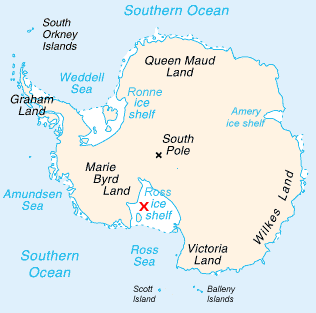At the very beginning of my Antarctic adventure (when I landed in Christchurch, NZ) I met a group of scientists that were coming to Antarctica to study how the
Ross Ice Shelf (RIS) interacts with ocean waves. We stayed at the same hotel in Christchurch and then did much our McMurdo training together. They are a fun bunch of characters and their research is very interesting so I thought I'd share some of it here. I call this group "Team IceVibes" - Peter Bromirski (Uni. California, San Diego; UCSD), Ralph Stephen (Woods Hole Oceanographic Institute; WHOI) and Peter Gerstoft (UCSD) are the lead investigators along with Ron Flick (UCSD).
As I mentioned in a prior post, an ice shelf is a floating mass of ice formed when glaciers or ice
sheets flow over the coastline. Because it is already floating, if an
ice shelf melts or disintegrates it will not contribute to sea level
rise (but it's removal could prompt terrestrial ice to flow into the
ocean at a faster rate). Sometimes
ice shelves collapse in spectacular fashion, but the mechanism for this is not completely understood, hence their study.
 |
| Ross Ice Shelf (RIS) marked with a red "x". McMurdo is on the right hand edge of where the RIS meets the Ross Sea in the above image. Source: Wikimedia |
"Team IceVibes" are going to camp out on the RIS for three weeks and their aim is to see the effect of oceanic infragravity waves upon the RIS - i.e. do these waves make vibrations in the ice? And if so, how strong are these movements? Could these movements contribute to ice shelf collapse? Infragravity waves are formed when "normal" wind waves (surf and ocean swell) interact with shallow water regions and transfer some energy to a longer wavelength form; these longer waves can travel vast distances e.g. from the coast of California all the way to Antarctica.
Seismometers, which detect movement in the ground, will be used to see whether these waves make the ice shelf move vertically.
Correction/Update: The item being detected is a velocity (motion of the ice) and the displacements are on the order of picometers (1/1,000,000th of a millimeter). The unit of measurement is called a a
Microseism. The instruments need to be very accurate and precise! (Thanks to Peter G for the additional information.)
 |
| Team IceVibes are installing seismometers at all the black stars. Another team has seismometers at all the red stars - the scientific teams will be pooling all their data so everyone can have a better understanding of what is happening. The RIS is outlined in black and blue lines (with north being towards the top of the image). |
 |
| Team IceVibes staging vast amounts of equipment in the Crary Lab. |
 |
| Ralph and Peter G discuss the details of an instrument control unit in the Crary Lab |
The team flew out to "Yesterday Camp" and installing instruments at many locations. The camp gets its name from being on the other side of the
International Date Line compared to McMurdo Station.
 |
| The kitchen, dining and science tents at Yesterday Camp. Sleeping tents are behind the photographer. It is flat and white in every direction! Photo: Team IceVibes |
 |
| Installing a seismometer on the Ross Ice Shelf. Power is provided by the "lampshade" of solar panels and a GPS units tracks the horizontal motion - remember that ice shelves are constantly (though very slowly) moving towards open water in the ocean and can calve off giant icebergs. Data is transmitted by satellite to computers back in the US. Photo: Team IceVibes |
 |
| The actual seismometer is the cylinder buried deep in the hole. The instrument is set to level and pointing true north. Photo: Team IceVibes |
For more information about the science of ice shelf vibrations, visit the
website of Team IceVibes








